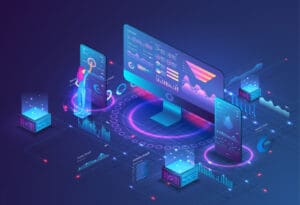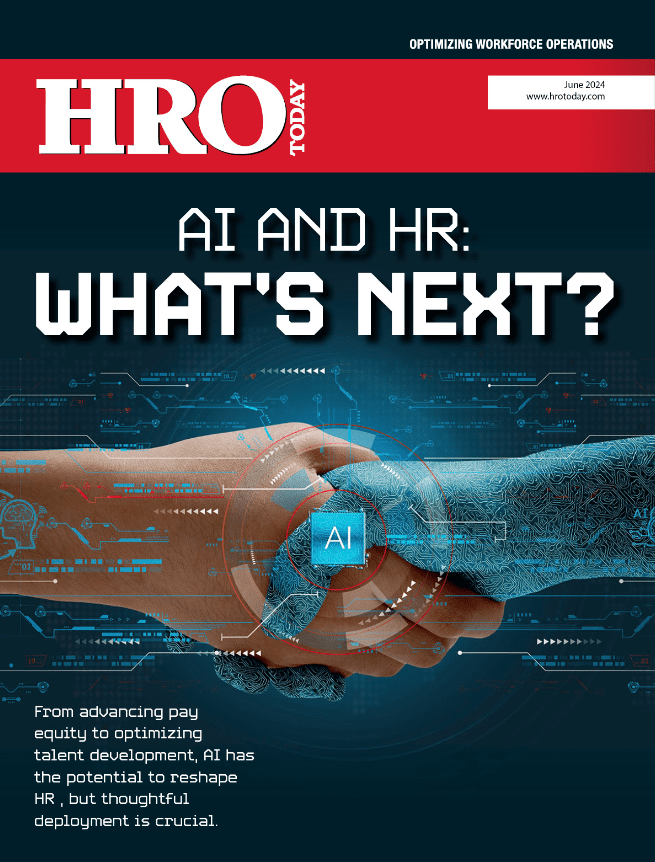Advanced technologies are popping up everywhere and they’re helping HR improve recruitment, communication, and productivity.
By Zee Johnson
Technology has taken many leaps and bounds in recent years, especially as cutting-edge artificial intelligence (AI) tools rise in popularity and utilization in the workplace.
A recent survey revealed that nearly one-third of leaders are redesigning their work and using AI to reduce their organization’s dependency on people, and 97% of leaders expect their organizations to be impacted highly (or extremely highly) by generative AI in the next 12 to 18 months.
With 57% of CEOs and CFOs planning to increase the use of AI and automation amid today’s economy, obvious questions arise–how will technology transform the workforce? Will it replace workers? And if so, when?
Will tech replace workers?
Tami Wolownik, head of people and organization, North America, at Siemens Mobility, knows that these days, innovation is happening at a lightening pace but says AI won’t be taking over the workplace anytime soon. “In our digital world, there’s concern that technologies like generative AI are too powerful and developing too quickly. These are valid concerns, but I think AI technology presents a real opportunity to enhance workers’ efforts, rather than replace them,” she says.
Fifty-four percent of U.S. employees expect or have already seen positive changes in their workload due to AI or automation. So, with human engagement and interaction being the epicenter of HR, employees should be welcoming of AI, not worried. “The bottom line is that AI can help free up repetitive, mindless, and often time-consuming tasks to help our people focus on innovation and big ideas,” Wolownik says.
Martha Delehanty, chief people officer at Commvault, thinks technology still has a ways to go, due to some noteworthy shortcomings. “Tech is great to engage and collaborate but can also encourage isolation. ChatGPT is fabulous, but you can’t just assume the content is correct; it’s only good as the storyboard created,” she says. “So, like most revolutionary technology, there will be huge benefits and unanticipated side effects.”
James Neave, head of data science at Adzuna, on the other hand, sees it possible that tech will make some role replacements. It all depends on the sector.
But he notes that skilled, manual jobs are at a low risk of automation, as well as positions that would be hard, if not impossible, to digitize. They include:
- mechanics;
- carpenters;
- plumbers.
- CEOs;
- judges;
- politicians;
- childcare jobs (pediatricians, nannies, and midwives); and
- influencers, life coaches, and personal trainers.

57% of CEOs and CFOs plan to increase the use of AI and automation amid today’s economy.
How will it help continue to attract and retain talent?
Technology has long been an anchor in talent management, and now with the addition of generative AI tools like ChatGPT, it can be used in more ways than ever before. A survey by Glider revealed that AI hiring tools can reduce the time to fill a position by 50%, making the recruitment process far less tedious.
Wolownik says that ChatGPT is particularly helpful in creating standout job postings that attract the best talent and acting as an aide to HR teams. “ChatGPT can be used to create more robust yet specific job descriptions and postings, personalize sourcing, screen resumes, and help find and attract the best matched candidates to a particular job role,” she says. “It can even support HR teams during the candidate recruitment process by automatically answering candidate questions and providing them with details on a job role.”
Managing Partner of Global Human Resources for DHR Global John Staines says that every company should be implementing technology because it has been critical in helping organizations stand out in the market by advancing processes and freeing up executives for more strategic work. “Companies and HR teams that ignore or resist these changes will lose their competitive edge,” he says.
ChatGPT can be used to improve time-consuming, task-oriented procedures commonly used in HR, Staines explains, especially in talent attraction and retention. For example, technology can:
- generate HR documents like interview guides;
- formulate questions for behavioral interviews;
- perform a basic compensation analysis;
- benchmark employee benefits; and
- develop templates for standard job descriptions.
With 51% of companies investing in their current workforce and focusing distinctly on upskilling and training, Delehanty thinks AI is most beneficial when upskilling current employees and aiding in career growth. “Employers shouldn’t neglect the most valuable resource they already have–their existing employees. Seeding and growing talent from within will increasingly be a big part of the AI solution,” she says. “If you expose your colleagues to AI tools, and teach them how to use AI wisely, you not only enable your employees but help to ensure that the technology is put to its best use.”
But for AI to truly make a difference in talent attraction and retention, it must help strengthen the cornerstone of all organizations–communication. This includes leveraging it for things like initial correspondence with prospective job seekers, welcoming new hires to the team, seeing candidates through the onboarding process, and more. AI automates these steps making them quick and virtually effortless.
“It is essential for leaders to take the reins, make AI a force for good, and use it to scale and reverberate their most important messages,” says Connie Marean, vice president of people at Axios HQ. “The premium on clear, crisp communication at scale that can break through and connect with prospective employees and internal audiences has never been higher. If you want to retain and attract top talent, you need to master communicating what your company or product stands for.”
Does technology and workplace culture go hand in hand?
Communication isn’t just essential in recruitment and retention, but also for driving an authentic workplace culture.
eLearning Industry’s The State of Employee Experience 2023 report found that culture and camaraderie are important parts of an employee’s integration into the organization. In fact, one-quarter of employees said they want to learn about the culture, benefits, and overall operations of a company before onboarding.
Janet Mertens, senior vice president of research at the Josh Bersin Company, says that through proper communication and efficient technology, companies can achieve a culture of trust and transparency. “How an organization applies technology for communication, for example, can make a huge difference to the workforce experience,” she explains.
She details an organization’s success after it realized traditional communication channels weren’t effective for their workforce. So, they decided to get personal–and it worked wonders for their culture. “Shifting to a communications platform that encouraged peer-to-peer, ground-up, and lateral communication shifted its culture within a year, with employees sharing innovative ideas and bridging the distance from front-line to leadership,” she says.
Marean says that in a digital, often dispersed world, using technology to create a strong culture is critical. “In today’s working world, for many of us, there is no physical office, so the technology tools you choose are how people understand and interact with your company. They are mechanisms that define your culture,” she says. “It’s about creating the virtual manifestation of how your teams get to know each other, build affinity for your organization, and get work done.”
She adds that the right mix of tools can help everyone in the organization understand what they’re working toward and can help teams build relationships and stay in sync.
“People used to have so much agency in how they communicated with one another–coffees, quick walks, meetings, happy hours. Now they only get to use the tools and channels you define–Zoom, Slack, and whatever else you add to the mix,” she says. “The medium is the message. It has never been more important to get the medium right.”

54% of U.S. employees expect or have already seen positive changes in their workload due to AI or automation.
Can tech actually boost engagement?
One of the most important byproducts of a solid culture is increased employee engagement levels, which positively impact productivity and the bottom line.
“Companies today are using AI to build a comprehensive view of employee engagement,” Staines says. “AI can help you get a quick read and allow you to make informed decisions on what changes you and your leadership team need to make to drive engagement and performance.”
Wolownik provides some best practices that leaders can use to make this a reality.
- Use AI reports to monitor employee engagement. Collect data and find common themes within employee feedback. Then analyze that data and take the steps to improve.
- Connect employees with learning tools to support career growth. Offer digital learning tools for all employees to stay up-to-date on skills and best practices. At her company, My Learning World offers employees a wealth of learning with interactive trainings on topics like AI, digitalization, mindfulness, DEI, and more.
Another factor to engagement is connection, but 43% percent of respondents in a recent report say they don’t feel a sense of connection, especially to their co-workers. How can AI help? Marean provides two examples.
- Use data-driven decision-making. Analyze survey data, employee sentiment, and performance trends to scope for changes. Also, use AI to automate data cleanup, offer pattern recognition–like moments of high or low engagement, or identifying turnover markers–create charts and visualizations, and even attempt to forecast future trends based on data.
- Personalize employee experiences. Create cohesive, customized internal communications for employees across the company. Whether offering an AI-powered chatbot to help people find resources or launching a new, recurring communication, AI can feed relevant insights to each particular segment.
What does AI’s future look like?
Recent Josh Bersin research shows that AI-supported talent intelligence is providing real-time insights into time-to-hire challenges and labor market trends that decision makers lean on for vital information. Merten says that in the future, AI will continue helping leaders be more strategic when it comes to hiring, succession planning, and the employee experience.
“Leaders have historically struggled with development planning and performance management, as best practices need to combine with personal judgment,” she says. “With generative AI, a system could index a year of an employee’s work: hours worked, meetings, and other production and then provide managers with detailed reports about these efforts. Generative AI could also compare these activities with similar roles and show where the employee was outperforming and perhaps underperforming.”
An Adzuna report saw that there were 1,493 more job ads citing generative AI in May 2023 compared to May 2022 (1,496 and 3, respectively). This signifies just how important and impactful AI’s presence has been and will continue to be.
“AI is going to permeate society in the same way that the internet has, massively lowering the barrier to entry to individuals in many sectors. Creative industries (music and filmmaking) will be transformed, and we are already starting to see the first fully AI-created videos,” Neave says.
Generative AI is here to stay, and Staines says that if leaders remain receptive to these advancements and leverage them properly, some of the most important aspects of business will improve. “My thinking around AI and ChatGPT is that this technology is our new reality, and I am sure more new technology is coming,” Staines says. “We need to figure out how to embrace it, and how to use it to improve the employee experience. There will always be HR functions that will require a human touch, so don’t focus on the negative aspects of this change. Embrace it and define your own future.”














